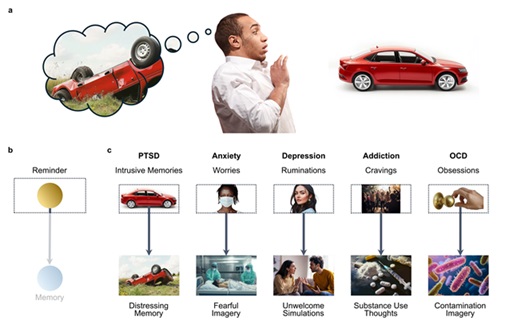Ever wish you could stop a thought in its tracks? Whether it is a painful memory, an intrusive worry, or just a distracting mental image, our brains can actually learn to shut those thoughts down, and a major new review reveals how.
A recent review article published in Nature Reviews Neuroscience (featured on the journals cover) by researchers from the MRC Cognition and Brain Sciences Unit (MRCCBU), University of Cambridge, and Stanford University synthesizes a vast body of research to uncover the key brain mechanisms that allow us to suppress intrusive thoughts, a process crucial for mental health. The paper, led by Dr Michael Anderson (MRC CBU), with co-authors Dr Maite Crespo-Garcia (MRC CBU) and Dr S. Subbulakshmi (Stanford), argues that the brain’s right prefrontal cortex plays a central role in halting unwanted memories, much like it stops physical actions such as pulling your hand away from a hot stove.
Drawing together findings from neuroimaging, brain stimulation, neurochemical, and behavioural studies, the review highlights the importance of a specialised pathway between the prefrontal cortex and the hippocampus in enabling thought suppression. A brain chemical called GABA (gamma-aminobutyric acid) plays a major role in this process. The more GABA present in the hippocampus, the better people are at forgetting thoughts they want to avoid.
Why does this matter? Because many mental health conditions like PTSD, anxiety, and depression involve intrusive thoughts that people struggle to control. This review suggests that problems with the brain’s “thought-stopping” circuit may lie at the root of those symptoms. Better yet, it also highlights emerging evidence that people can train this ability, and that doing so might help reduce emotional distress.
Participants in experimental studies who practiced thought suppression not only remembered less of the unwanted content, but also felt less anxious or upset when reminded of it later. This review turns outdated assumptions about suppression on their head, showing that under the right conditions, stopping thoughts can be a powerful tool for emotional regulation.
The article appeared on the cover of Nature Reviews Neuroscience and can be read here: https://www.nature.com/articles/s41583-025-00929-y

 MRC Cognition and Brain Sciences Unit
MRC Cognition and Brain Sciences Unit


